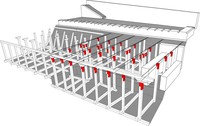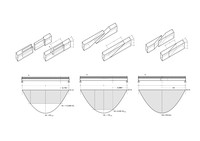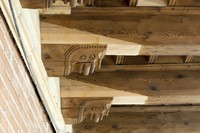Landa Mikel, Ochandiano Alazne (Elorrio, Spain)
Minimal intervention and application of technology based on the use of wood for repair and strengthening of wooden architecture monuments
 @kizhi
@kizhi



Summary: The article deals with the issue of authenticity applied not only to material but also to the structural function in wooden heritage. It develops the idea of the appropriateness of using wood to solve the problems of wood and shows a short panorama of the possibilities that traditional joints, evolutions of them and newly designed solutions give to the conservator.
Keywords: authenticity; Grafts; wooden heritage; repair; compatibility; soft techniques;
Аннотация: Минимальное вмешательство и применение технологии, основанной на использовании древесины для ремонта и укрепления памятников деревянного зодчества. В статье рассматривается вопрос подлинности памятников деревянного наследия не только в отношении материала, но и их структурной функции. Развивается идея целесообразности использования древесины для решения проблем деревянных памятников. Предлагается краткий обзор возможностей, которые представляет реставратору применение традиционных соединений, их эволюция и новые решения.
Ключевые слова: подлинность; протезы; деревянное наследие; ремонт; совместимость; щадящие технологии;
Minimal intervention and authenticity
As stated in the Principles for the preservation of historic timber structures [1] , the primary aim of preservation and conservation is to maintain the historical authenticity and integrity of cultural heritage [2] . Authenticity is often related to material conservation and thus, to keeping as much as possible [3] of the existing material. The concept of minimum intervention involves avoiding the removal of wooden elements or parts of elements from the original structure unless due to force majeure reasons.
However, Conservation of Cultural Heritage understood from an integral perspective involves considering, not only the material but also its intangible side. That intangible side might in some cases be crucial to design conservation policies [4] regarding to wooden heritage or to heritage with relevant presence of wood. In this article we will concentrate in the effect of two specific aspects of the intangible side of wooden heritage that are most common in wooden heritage conservation: the structural function and the use.
The structural function
To retain as much as possible of the existing material seems to be a subject of quantity, and as a consequence, it could be stated that the more material is kept the better authenticity is preserved, in any intervention of a wooden building. But being quantity important, there are other aspects related to the conservation approach that are to be considered.
Wood is a material that has been and is still widely used in many parts of a building, with a large number of examples in different cultures that have been built completely or almost completely by the only use of timber elements, one of the main parts of them being the structure. Approaches to the preservation of a wooden structure may be diverse, one of them being to stick to the idea of keeping as much material as possible avoiding the removal of any part of the structure including the damaged parts. [текст с сайта музея-заповедника "Кижи": http://kizhi.karelia.ru]
Pushing this reasoning to the limit, a wooden element that has suffered damage due to, for instance xylophages, and is not in condition to support the stresses any longer will have to be kept on site due to its material value, but will see its structural function replaced by other means.
Nonetheless, the structural function of a wooden structure is relevant to help understand its authenticity. And as a consequence, its conservation is an issue to be considered as a relevant part of the whole structure. The principle of minimal intervention, thus, should be reformulated as an approach that balances the need to retain as much as possible of the material of a wooden structure with the preservation of the structural function [5] . Accordingly, it is relevant that the preservation of a structural wooden construction includes every effort necessary to maintain its resistant function.
Frequently, the conservator has to intervene in a wooden frame that has suffered pathologies that have reduced structural functionality of an element, set of elements or structure. The intervention in that case should be aimed to recover that said functionality. We will define repair as all the actions [6] aimed to recover the lost structural efficiency of a wooden element or frame. If the pathology results in deformations that endanger the stability, repair could be defined as those actions aimed to recover a secure geometry for the structure with the minimal alteration of the actual shape.
Within the minimal intervention approach, repair is the action to be carried out to preserve the structural action of a wooden structure, while keeping as much as possible of the existing material.
Conservation and use
It might result that a structure has not suffered any damage or loss of efficiency, and still an intervention is needed. A change of use in a building might affect to its authenticity, but in occasions it is needed in order to secure the survival of the building itself. Spain is a country with a rich and diverse heritage, and a change of use is frequently implemented with the purpose of preserving the building. Frequently, one of the consequences [7] of the change of use is an increase in loads affecting to the structure. Under these conditions it might be that the structure is not capable to resist the new conditions, forcing the conservator to intervene in order to increase the structural efficiency.
We will define thus, to reinforce as the actions aimed to increase the structural efficiency of an element, ensemble of elements or the whole structure, meaning to adapt it to the new situation.
Intervention techniques
Wood joints in our cultural environment have limited or no capacity at all to support moments. As a consequence, wooden structures are usually isostatic, or have a high degree of isostaticity. One of the features of isostatic wooden structures is that each element is independent from surrounding elements and their relation is through force transmitting planes. And as a consequence, a single structural element can be repaired, reinforced or replaced without altering the structural functionality of the ensemble.
This attribute enables to focus the issues related with built heritage preservation with very different scopes, as might be the single element, a part of the structure or the construction as a whole. Similarly, any intervention in a wooden structure should keep the relation among single elements without altering the structural function of each one of them. Provisos to this assertion might be considered when the preservation of the structural function implies corrections [8] to the original frame due to pathologies or changes in the load path.[текст с сайта музея-заповедника "Кижи": http://kizhi.karelia.ru]
Wooden architecture is diverse, as diverse are the climates, cultures, traditions, tools, techniques and species that affect it. Having specific features that differentiate it from the rest, the knowledge required to intervene in wooden heritage has also to be specific. Accordingly intervention techniques are also specific. Being true that techniques have to be dependent on the project [9] , it is also true that they have to be mastered to be able to design freely. Lack of knowledge about the material, the architecture built with it and the intervention techniques result in a dramatic loss of wooden heritage. Whoever masters the preservation theory but not the techniques will be unable to accomplish his ideals, risking using his theoretical knowledge to justify the loss of heritage. Otherwise, whoever masters the techniques but not the theory might solve specific issues without knowing the adequacy of the techniques or the approaches implemented.
Techniques aimed to repair or reinforce wood might be based in a variety of materials and approaches. Those techniques based on the use of materials alien to wood to remedy the pathologies of wood receive the name of prosthesis. Besides, there is a wide range of techniques that rely on wood as the main material for the intervention in wooden structures. Those repairs are named grafts.
Soft repair techniques: grafts
We might define a graft as a repair or reinforcement carried out in a wooden structural element with the only use of wood and joining both parts with joinery, fasteners, glue or a combination of them. The use of grafts is widespread in a number of cultures and regions, but mostly in those with a strong tradition in the use of wood. These techniques have been used in the past and are still in use in countries such as Japan [10] , Slovakia and Norway [11] .
The design of each traditional wooden joint has been led to satisfy a specific structural need. The skills to use them in the proper place are on the base of creating wooden architecture [12] . A carpenter that masters the design and construction of traditional wooden joinery will be inclined to use his knowledge when facing the repair of a wooden structural element. The use of wood joints to repair wooden structural elements is thus, a natural choice. [текст с сайта музея-заповедника "Кижи": http://kizhi.karelia.ru]
In the case of a wooden post that has suffered decay in its lower end due to the action of fungi, a logical repair would consist in removing as little as possible of the damaged wood, and adding wood to complete the structural element. A number of wood joints can be used to transmit the compression efforts, with are axial, being the moment due to bucking minimal (Image 1: Añana Salt Valley. Spain. Terraces built with wood and stone, and waterproofed with clay support the evaporation pans of a millenary saltworks. A differential settlement on the wooden base of one of the terraces, turned the evaporation pans on top unusable. The repair consisted in extending the posts with wood, joining both parts of the pillar with a tenon lap joint. The ensemble is fastened with wooden pegs.).
But beyond the appropriateness and many advantages of the use of wood joints in repairing wooden structures, their structural efficiency is limited. As stated above, wood joints have a limited capacity to support bending moments. This fact is the main reason for the use of braces in wooden architecture. Scarf joints or lap joints are not used to repair a damaged beam as they have no capacity to resist moments. The addition of pegs or rods will give those joints a certain structural capacity, but even so, their efficiency is limited [13] . As a consequence, this kind of repair is recommended to be used in limited bending moment parts of a wooden structural element.
To improve the transmission of loads, carpenters often redesign the shape of the traditional joints and make them more complex. Variations to the traditional wood joints are aimed to improve the response under certain structural conditions. However, the limitations still exist, and in occasions the carpenter feels more secure including glue in addition to the pegs.
The repair of a wooden element with wooden grafts involves to remove the damaged part of the element and to replace it with a fragment of wood. The efficiency of the ensemble is related with the efficiency of the joint. To make the repair suitable for a specific situation, it needs to be designed to resist the efforts that the element suffers in the position that holds in the element. As an example, in the case of a beam it is obvious that a graft placed in the centre of its span will have to resist higher moment than another repair placed closer to the end of the beam (Image 2: Three different solutions for repairing a beam by the use of glued wooden grafts. The use of glue increases the efficiency of the joint, its limitation being the design of the contact planes. Each one of the designs shown is appropiate for certain structural situations., reaching in the case of the vertical oblique scarf joint the so called continuity of material).
Seeking to achieve the maximal possible structural efficiency [14] , to glue the contact planes of the wood joint assures a good transmission of efforts avoiding concentration of stresses [15] . When using glued joints complete structural efficiency can be achieved under certain circumstances. This fact involves that a damaged wooden element can be repaired to a point that it recovers its full original structural resistance. Said in other words, in the case of a beam a joint can be designed to resist the maximal bending moment, to achieve continuity of material. [текст с сайта музея-заповедника "Кижи": http://kizhi.karelia.ru]
Wood to repair wood
Understood as the natural solution in many cultures, the use of wood to solve the problems of wood is not the first choice in many others. Lack of knowledge is in the base of that attitude, not only affecting to craftsmen [16] but to the whole ensemble of actors involved in the process, including architects. As a consequence, a relevant factor in facing the conservation of wooden heritage is to recover the knowledge of the craftsmen that helped create that architecture and to develop and research techniques based in the specificities of wood (Image 3: Condestable Palace. Pamplona. Spain. This 400 year old palace was built with mansonry walls and wooden floors made of pine. Saved from being demolished, a project was carried out to recover the structural function and adapt it to the new use, with the only incorporation of wood. Punctual repairs were carried out to solve damages and pathologies, and new solutions were designed and developped to reinforce, with wood, the wooden floors. Design: Tabuenca and Leache architects. Structure: Landa and Ochandiano architects.).
Authenticity of wooden heritage understood as a balance of keeping as much as possible of the original material, with the respect of the structural function, can be best achieved by using wood as the main material in conservation. For centuries, Japanese carpenters have repaired wooden structures cutting out the damaged parts, replacing them with wood and joining both parts with joints, respecting thus, the most of the original structure. Other countries also have a long tradition in applying this approach.
Although not systematized nor organized, there is a large catalogue of solutions spread in many countries, valid to face an extensive collection of pathologies of wood. Of those, many are based on the use of traditional joinery while others have been designed anew but derived from traditional joinery adapted to specific requirements. The selection of a specific technique resides in the conditions of each case, and the conservation approach.
Wooden solutions have limitations while give possibilities, and share with the original material the specificities of wood, offering one of the most interesting features in conservation: compatibility.[текст с сайта музея-заповедника "Кижи": http://kizhi.karelia.ru]
Photograph. Author: Mikel Landa. Copyright: Landa-Ochandiano arquitectos
- [1] “the primary aim of conservation and preservation is to maintain the authenticity of the historic fabric.” ICOMOS IIWC (2016) Principles for the conservation of wooden built heritage. IIWC. Art. 5. Actually in process of revision.
- [2] ICOMOS. IIWC (1999). Principles for the preservation of historic timber structures. IIWC. Art. 4.
- [3] “the major objective of current preservation theory and practice is to retain as much as possible of the existing materials of the historic building” Larsen, K.E.; Marstein, N. (2000) Conservation of Historic Timber Structures. An ecological approach. Bath. Butterworth-Heinemann. p. 14.
- [4] Landa, M., Ochandiano, A., Lasagabaster, J. I., Azkarate, A., & Avalos, A. (2004). Master Plan for the Integral recovery of Añana Salt Valley. Vitoria-Gasteiz: DFA.
- [5] Yeomans, D. (2007) Appropriate technologies for conservation. Journal of Architectural Conservation. Donhead Publishing. Dorset. p. 15.
- [6] “repair is a painstaking intervention in the historic fabric, aiming at replacing only decayed parts and otherwise leaving the structure and the materials intact”. Larsen, K. E. (1994). Architectural Preservation in Japan. Trondheim: Tapir publishers.
- [7] Henrichsen, C. (2003b). Reparaturen und statische Sicherungen an historischen Holzkonstruktionen. Stuttgart: Konrad Theiss verlag.
- [8] Yeomans, D. (2003). The Repair of Historic Timber Structures. London: Thomas Telford Publishing, p.131.
- [9] “Ma condivisibile credo sia il concetto che le techniche siano in subordine al progetto.”Laner, F. (2005). Tecnologia del recupero delle strutture lignee. Verona: Peter Cox.
- [10] Hyunjung, C. (2011). A study on the members of Historic Wooden Architecture, Conservation Methods and Repair Techniques. Tokyo: Doctoral Thesis.
- [11] When visiting old wooden buildings in Norway and Slovakia, but also in many other countries, repairs carried out by the use of traditional or variations of traditional joinery are apparent to the eye. Solutions vary in shape but usually have a relation with the local joinery tradition.
- [12] “When making any joint, the carpenter must keep in mind the purpose for which that joint is intended.” Zwerger. (2012). Wood and wood joints. Basel. Birkhäuser. p. 100.
- [13] Mettem, Page, & Robinson. (1993) Repair of structural timbers. Part 1. Test on experimental beam repairs. High Wycombe. TRADA.
- [14] “Since the function of a joint is to transmit load from one element of the structure to its neighbour, stress has somehow got to get itself out of one piece of material and then get itself into the adjoining piece; such process is only too likely to result in severe concentrations of stress and consequent weakness.” Gordon, J.E. (1987) Structures, or why things don’t fall down. London. Penguin Books Ltd. P. 130
- [15] Landa, M. (1997) Behaviour of glued joints for the repair of structural bending wooden elements. Pamplona. UNAV. Doctoral Thesis.
- [16] “The need to use modern materials in repair work may also result from the lack of competent craftsmen.” Larsen, K. E., & Marstein, N. Op.cit, p.5.
Текст может отличаться от опубликованного в печатном издании, что обусловлено особенностями подготовки текстов для интернет-сайта.
